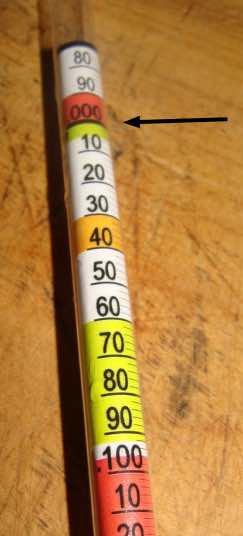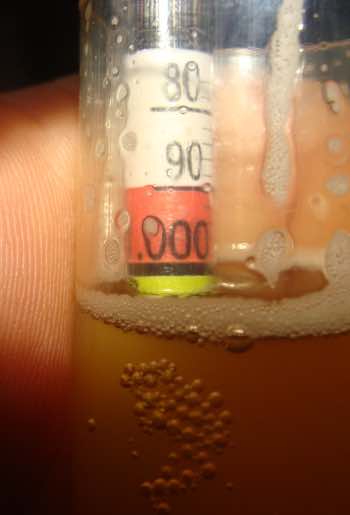- Bernard Preston homepage
- Beekeeping
- Beer Hydrometer Readings
Beer hydrometer readings
Beer hydrometer readings are necessary for every brewer who stores his tipple under pressure.
This is of vital importance to the home-brewer. You absolutely must have a hydrometer. Fortunately they are not expensive.
Should you bottle your beer before fermentation is complete, the pressure will build up to dangerous levels. A potentially lethal explosion is imminent with flying glass shrapnel.
Credit for the hydrometer is given to a Greek man, Hypatia living in Egypt; in that centre of wisdom, Alexandria. But it was Archimedes who worked out the principles of density and specific gravity.
It is a wonderful invention; in this instance, it really should be called a saccharometer as it measures how much of the sugars in the honey in your beer or mead are left unfermented.
In this instance the saccharometer is buoyed up by the sugars left in the wort. As they are converted to alcohol it sinks lower until it approaches a reading of 1.000, the same as water.

This page was last updated by Bernard Preston on 6th April, 2021.
An alcohol concentration of around 5 percent gives a reading of about 1.040, or simply 40 in the jargon. That is from 1kg of sugars in 25 litres of wort.
A light beer might start with only 400g of sugar and will of course be lower in alcohol; an initial hydrometer reading around 20.
If you look at the very top you'll see 0.980, then 0.990. The next readable point is 1.000.
Therefore the next is 1.010; this means you have 10 g of sugar per litre of liquid.

SG
Water
Beer and dry mead finish
Sweet mead finish
Beer start
Dry mead start
Sweet mead start
Hydrometer
- 0.980
- 0.990
- 1.000 (water)
- 1.040
- 1.010
- 1.020
- 1.040
- 1.050
- 1.060
- ...
- 1.090
- 1.100
- 1.120
- 1.110
- 1.150
Reading
- 80
- 90
- 1.000
- 04
- 10
- 20
- 50
- 90
- 1.100
- 10
- 50
Final %ABV
5%
13%
17%
Beer hydrometer readings
Beer hydrometer readings are vital if you do not want dangerous bursting bottles and flying glass shards.
Braggot is a beer made using honey instead of sugar; it is usually stronger with an initial reading of 60 and sometimes much higher.
As the honey is converted to alcohol and carbon dioxide, the hydrometer sinks lower in the container.
As you can see here, the reading is about 1.04, very close to that of water. It is time to bottle my beer.
Bottling when the SG is 1.08 is safe and the resulting beer will be slightly sweeter.
Meads and braggots oddly are not necessarily sweet at all. All the sugars in the honey have been converted to alcohol. It is the fragrances of ten thousand flowers that will make them taste quite different to ordinary wine and beer.

Making honey mead
Making honey mead and a braggot is fun, but in truth it is only really for the beekeeper. It is quite a lot of work and so there is no point using second-grade ingredients; hydrometer readings are vital to produce a good brew.
Fermenting honey to make a beverage is older than the taste of ice-cold water; better too, though of course the ancients never had any hydrometers; they would not have bottled in glass. Not until the fifth-century anyway, thanks to our friend Hypatia though I am sure it was not in common use really until the last century.
They brewed and immediately drank their beers and wines mostly; though leather sacs could be used to keep strange yeasts out. Making honey mead is one of my passions; it is one way to utilise the gleanings and put them to good use. If you are going to bottle it, you must have the ability to take hydrometer readings.
Choice foods
Choice foods are not that easy to obtain; you have to work quite hard to find those vittles that you know are to your liking. I will not suggest that beer is one of the necessities of life. It is more of a hobby than anything else for me.
But if you are going to enjoy alcohol with your food, and bottle it yourself, then beer hydrometer readings are a must.
Can beer, claret and mead be numbered amongst the choice foods? Yes and no is the answer
Yes because homemade they are a probiotic and full of important vitamins, minerals and phytonutrients; and lower cholesterol in the case of red wine at least. They can in moderation be recommended as a choice food.
But no, because alcohol makes a good servant but a very bad master; and it is continually trying to upgrade its status from nave to prince.
And no, because the alcohol processing industry in many countries adds all kinds of preservatives and enzymes that move them to junk status. I find it interesting that commercial beers often give me severe heartburn but my homemade braggot does not.
It is all in the chemicals added to the tipple purchased at the bottle store.
And I find Tulbagh red wine from the Western Cape of South Africa gives me no collywobbles but many of the commercial varieties give me extreme discomfort several hours later.
The only alternative is to brew your own if you have a sensitive belly and for that you certainly need a hydrometer. They are not expensive; less than 10 dollars on Amazon.
Beer glucometer readings
If you are prediabetic as I am, then you may also want to know which foods give you a surge in blood glucose; that is what damages the linings of your arteries. And that means taking not beer hydrometer but glucometer readings.
Invite a friend who is diabetic to dinner; and to bring his glucometer. Here are my readings in the two central columns; with a sigh of relief it's confirmed that beer is not one of my offending foods.
Time (mins)
- 0
- 30
- 60
- 120
(mmol/L
- 4.3
- 5.2
- 6.5
- 5.6
(mg/dl)
- 78
- 94
- 116
- 101
Food
- Water + 2 glasses of beer
- 1 glass of beer
- Dinner
- 1 hour later
Beer: 1 quart or 730ml has 26 g carbohydrate
Dinner: Fresh lima and broad beans, broccoli, one egg, 1 slice 100 percent wholemeal bread and butter. 15 + 5 + 0 + 15 = 35g.
Total carbohydrate for the meal amounts to 61g.
That is far too much starch in one meal for a person who is obese, insulin resistant or frankly diabetic; but fair for an averagely robust individual. Owing to the nutritious mix, except the beer perhaps, there was no abnormal blood glucose surge. I cannot vouch for canned beans and commercial bread.
I declined the pasta, ice-cream and hot chocolate sauce. I know what they would have done.
Anything over 7.8 (140) is definitely verging on diabetes, which is what some carbs will do to my blood glucose.
Actually there is a fairly simple solution in my case but you may be different; a short ten minute walk after starchy food keeps my blood glucose down to safe levels. I should really do it subsequent to every meal.
This brown honey beer is where I am enjoying spending time during the Covid-19 lockdown.
When browsing use right click and "Open Link in New Tab" or you may get a bad gateway signal.
Newsletter
Our newsletter is entitled "create a cyan zone" at your home, preserving both yourself and Mother Earth for future generations; and the family too, of course. We promise not to spam you with daily emails promoting various products. You may get an occasional nudge to buy one of my books.
Here are the back issues.
- Lifestyle and ideal body weight
- What are ultra-processed foods?
- Investing in long-term health
- Diseases from plastic exposure
- Intensive lifestyle management for obesity has limited value
- A world largely devoid of Parkinson's Disease
- The impact of friendly bacteria in the tum on the prevention of cancer
- There's a hole in the bucket
- Everyone is talking about weight loss drugs
- Pull the sweet tooth
- If you suffer from heartburn plant a susu
- Refined maize meal and stunting
- Should agriculture and industry get priority for water and electricity?
- Nature is calling
- Mill your own flour
- Bake your own sourdough bread
- Microplastics from our water
- Alternative types of water storage
- Wear your clothes out
- Comfort foods
- Create a bee-friendly environment
- Go to bed slightly hungry
- Keep bees
- Blue zone folk are religious
- Reduce plastic waste
- Family is important
- What can go in compost?
- Grow broad beans for longevity
- Harvest and store sunshine
- Blue zone exercise
- Harvest and store your rainwater
- Create a cyan zone at your home
Did you find this page interesting? How about forwarding it to a friendly book or food junkie? Better still, a social media tick would help.
- Bernard Preston homepage
- Beekeeping
- Beer Hydrometer Readings
Address:
56 Groenekloof Rd,
Hilton, KZN
South Africa
Website:
https://www.bernard-preston.com